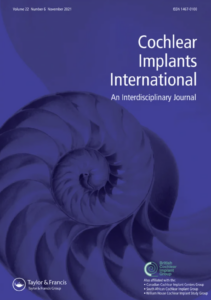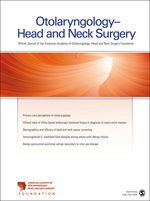3D-printing
Publication Types:

The cutting edge of customized surgery: 3D-printed models for patient-specific interventions in otology and auricular management-a systematic review
Purpose: 3D-printing (three-dimensional printing) is an emerging technology with promising applications for patient-specific interventions. Nonetheless, knowledge on the clinical applicability of 3D-printing in otology and research on its use remains scattered. Understanding these new treatment options is a prerequisite for clinical implementation, which could improve patient outcomes. This review aims to explore current applications of 3D-printed patient-specific otologic interventions, including state of the evidence, strengths, limitations, and future possibilities.
Methods: Following the PRISMA statement, relevant studies were identified through Pubmed, EMBASE, the Cochrane Library, and Web of Science. Data on the manufacturing process and interventions were extracted by two reviewers. Study quality was assessed using Joanna Briggs Institute’s critical appraisal tools.
Results: Screening yielded 590 studies; 63 were found eligible and included for analysis. 3D-printed models were used as guides, templates, implants, and devices. Outer ear interventions comprised 73% of the studies. Overall, optimistic sentiments on 3D-printed models were reported, including increased surgical precision/confidence, faster manufacturing/operation time, and reduced costs/complications. Nevertheless, study quality was low as most studies failed to use relevant objective outcomes, compare new interventions with conventional treatment, and sufficiently describe manufacturing.
Conclusion: Several clinical interventions using patient-specific 3D-printing in otology are considered promising. However, it remains unclear whether these interventions actually improve patient outcomes due to lack of comparison with conventional methods and low levels of evidence. Further, the reproducibility of the 3D-printed interventions is compromised by insufficient reporting. Future efforts should focus on objective, comparative outcomes evaluated in large-scale studies.
Keywords: 3D-printing; Additive manufacturing; Ear surgery; Otology; Patient-specific.74

Effect of 3D-Printed Models on Cadaveric Dissection in Temporal Bone Training
Objective: Mastoidectomy is a cornerstone in the surgical management of middle and inner ear diseases. Unfortunately, training is challenged by insufficient access to human cadavers. Three-dimensional (3D) printing of temporal bones could alleviate this problem, but evidence on their educational effectiveness is lacking. It is largely unknown whether training on 3D-printed temporal bones improves mastoidectomy performance, including on cadavers, and how this training compares with virtual reality (VR) simulation. To address this knowledge gap, this study investigated whether training on 3D-printed temporal bones improves cadaveric dissection performance, and it compared this training with the already-established VR simulation.
Study design: Prospective cohort study of an educational intervention.
Setting: Tertiary university hospital, cadaver dissection laboratory, and simulation center in Copenhagen, Denmark.
Methods: Eighteen otorhinolaryngology residents (intervention) attending the national temporal bone dissection course received 3 hours of mastoidectomy training on 3D-printed temporal bones. Posttraining cadaver mastoidectomy performances were rated by 3 experts using a validated assessment tool and compared with those of 66 previous course participants (control) who had received time-equivalent VR training prior to dissection.
Results: The intervention cohort outperformed the controls during cadaver dissection by 29% (P < .001); their performances were largely similar across training modalities but remained at a modest level (~50% of the maximum score).
Conclusion: Mastoidectomy skills improved from training on 3D-printed temporal bone and seemingly more so than on time-equivalent VR simulation. Importantly, these skills transferred to cadaveric dissection. Training on 3D-printed temporal bones can effectively supplement cadaver training when learning mastoidectomy.
Keywords: 3D printing; additive manufacturing; education; mastoidectomy; neurotology; otology; rapid prototyping; surgical simulation; temporal bone; training.

Cochlear Implant Surgery: Learning Curve in Virtual Reality Simulation Training and Transfer of Skills to a 3D-printed Temporal Bone—a prospective Trial.
Objective: Mastering Cochlear Implant (CI) surgery requires repeated practice, preferably initiated in a safe – i.e. simulated – environment. Mastoidectomy Virtual Reality (VR) simulation-based training (SBT) is effective, but SBT of CI surgery largely uninvestigated. The learning curve is imperative for understanding surgical skills acquisition and developing competency-based training. Here, we explore learning curves in VR SBT of CI surgery and transfer of skills to a 3D-printed model.
Methods: Prospective, single-arm trial. Twenty-four novice medical students completed a pre-training CI inserting test on a commercially available pre-drilled 3D-printed temporal bone. A training program of 18 VR simulation CI procedures was completed in the Visual Ear Simulator over four sessions. Finally, a post-training test similar to the pre-training test was completed. Two blinded experts rated performances using the validated Cochlear Implant Surgery Assessment Tool (CISAT). Performance scores were analyzed using linear mixed models.
Results: Learning curves were highly individual with primary performance improvement initially, and small but steady improvements throughout the 18 procedures. CI VR simulation performance improved 33% (p < 0.001). Insertion performance on a 3D-printed temporal bone improved 21% (p < 0.001), demonstrating skills transfer.
Discussion: VR SBT of CI surgery improves novices’ performance. It is useful for introducing the procedure and acquiring basic skills. CI surgery training should pivot on objective performance assessment for reaching pre-defined competency before cadaver – or real-life surgery. Simulation-based training provides a structured and safe learning environment for initial training.
Conclusion: CI surgery skills improve from VR SBT, which can be used to learn the fundamentals of CI surgery.

3D-printed models for temporal bone surgical training: A systematic review.
Objective: 3D-printed models hold great potential for temporal bone surgical training as a supplement to cadaveric dissection. Nevertheless, critical knowledge on manufacturing remains scattered, and little is known about whether use of these models improves surgical performance. This systematic review aims to explore (1) methods used for manufacturing and (2) how educational evidence supports using 3D-printed temporal bone models.
Data sources: PubMed, Embase, the Cochrane Library, and Web of Science.
Review methods: Following the Preferred Reporting Items for Systematic Reviews and Meta-Analyses guidelines, relevant studies were identified and data on manufacturing and validation and/or training extracted by 2 reviewers. Quality assessment was performed using the Medical Education Research Study Quality Instrument tool; educational outcomes were determined according to Kirkpatrick’s model.
Results: The search yielded 595 studies; 36 studies were found eligible and included for analysis. The described 3D-printed models were based on computed tomography scans from patients or cadavers. Processing included manual segmentation of key structures such as the facial nerve; postprocessing, for example, consisted of removal of print material inside the model. Overall, educational quality was low, and most studies evaluated their models using only expert and/or trainee opinion (ie, Kirkpatrick level 1). Most studies reported positive attitudes toward the models and their potential for training.
Conclusion: Manufacturing and use of 3D-printed temporal bones for surgical training are widely reported in the literature. However, evidence to support their use and knowledge about both manufacturing and the effects on subsequent surgical performance are currently lacking. Therefore, stronger educational evidence and manufacturing knowhow are needed for widespread implementation of 3D-printed temporal bones in surgical curricula.
